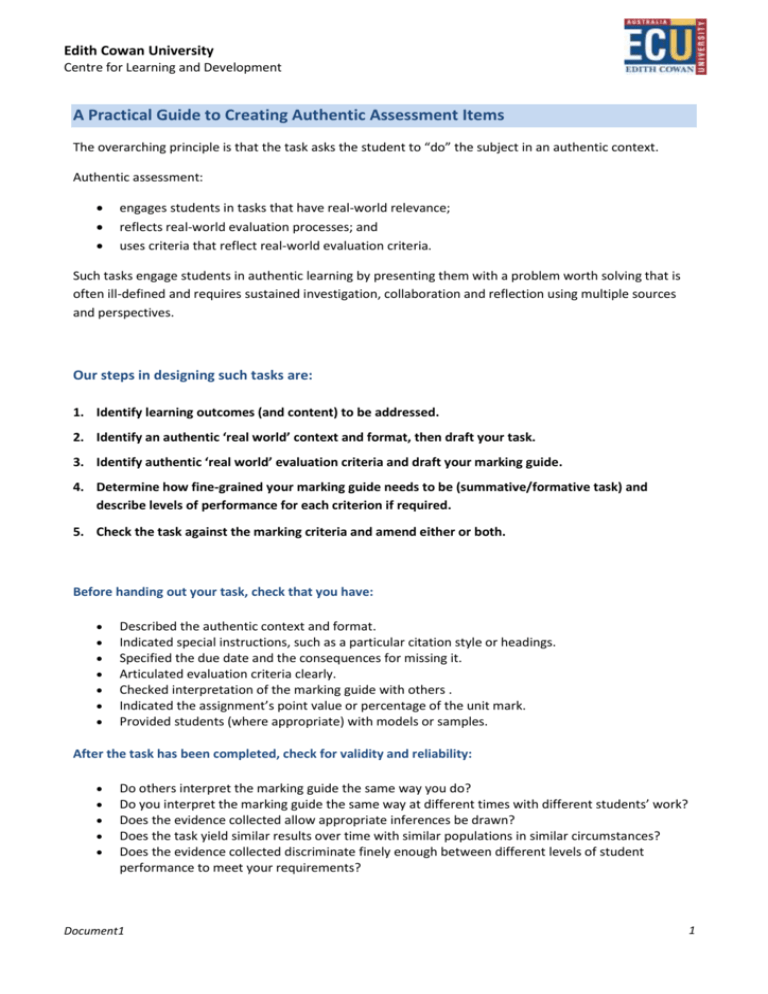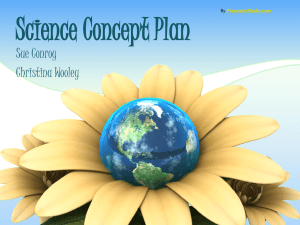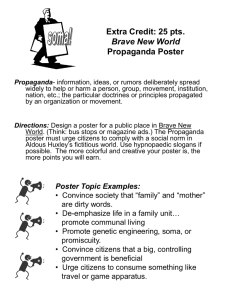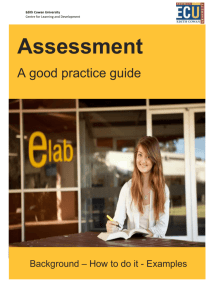A Practical Guide to Creating Authentic Assessment Items
advertisement

Edith Cowan University Centre for Learning and Development A Practical Guide to Creating Authentic Assessment Items The overarching principle is that the task asks the student to “do” the subject in an authentic context. Authentic assessment: engages students in tasks that have real-world relevance; reflects real-world evaluation processes; and uses criteria that reflect real-world evaluation criteria. Such tasks engage students in authentic learning by presenting them with a problem worth solving that is often ill-defined and requires sustained investigation, collaboration and reflection using multiple sources and perspectives. Our steps in designing such tasks are: 1. Identify learning outcomes (and content) to be addressed. 2. Identify an authentic ‘real world’ context and format, then draft your task. 3. Identify authentic ‘real world’ evaluation criteria and draft your marking guide. 4. Determine how fine-grained your marking guide needs to be (summative/formative task) and describe levels of performance for each criterion if required. 5. Check the task against the marking criteria and amend either or both. Before handing out your task, check that you have: Described the authentic context and format. Indicated special instructions, such as a particular citation style or headings. Specified the due date and the consequences for missing it. Articulated evaluation criteria clearly. Checked interpretation of the marking guide with others . Indicated the assignment’s point value or percentage of the unit mark. Provided students (where appropriate) with models or samples. After the task has been completed, check for validity and reliability: Do others interpret the marking guide the same way you do? Do you interpret the marking guide the same way at different times with different students’ work? Does the evidence collected allow appropriate inferences be drawn? Does the task yield similar results over time with similar populations in similar circumstances? Does the evidence collected discriminate finely enough between different levels of student performance to meet your requirements? Document1 1 Good authentic assessment tasks will require: organisation, synthesis, interpretation, or evaluation of complex information in addressing a concept, problem, or issue; consideration of alternatives, understanding and use of ideas, theories, or perspectives central to the discipline; use of methods of inquiry characteristic of the discipline to address a concept or problem connected to life beyond the classroom; and communication to an audience beyond the lecturer. Example 1 – Writing a new authentic assessment item. We follow the above steps. 1. Identify learning outcomes (and content) to be addressed. Go to the unit outcomes and select those that can realistically be assessed at this point in the unit. Here are some outcomes taken from a Psychology unit and adapted for this example. LEARNING OUTCOMES On completion of this unit, students should be able to: 1. compare the major concepts and propositions of personality theories and research; 2. compare the major concepts and propositions of intelligence theories and research; 3. analyse the influence of biological, interpersonal, and cultural factors on the development of individual differences; 4. critique a published paper, and demonstrate that ability through a written communication; 5. select and apply theories of individual differences to diagnosis and therapy, and to training and organisational development; 6. produce a comprehensive literature review; and 7. evaluate psychologists’ behaviour in psychological research and other professional contexts in relation to the Australian Psychology Society “Code of Ethics” and the complementary “Ethical Guidelines”. In this assessment for the unit the lecturer decide that she would assess outcome 2: 2. compare the major concepts and propositions of intelligence theories and research; 2. Identify an authentic ‘real world’ context and format. Draft your task. Students would be asked to compare major concepts and propositions of intelligence theories.. There are many ways to compare without relying on a traditional essay. For example: Poster; Presentation to the class; Presentation to a peer; and Presentation to a member of industry (Psychologist). Document1 2 These presentations would involve words and pictures. Other media such as video could be used. The lecturer decides that each student is to produce an A3 poster. This would reduce her marking burden and would be motivating for students. She would display posters in a tutorial session and ask students to speak to their poster in 60 seconds. This way much knowledge could be shared. She would also allow time for students to view other posters. Displaying posters was an accountability mechanism. She also considers peer marking. Concepts Compare three different definitions of intelligence Compare two different ways of measuring Intelligence Compares research about general and primary factors Compare two different theories of intelligence Indicator Compared in terms of history and utility Compares two ways in terms of method Compares general and primary and makes a conclusion at whether either or both exist Compares any two of usual, triarchic or multiple multiple intelligences in terms of history, intellectual rigour and utility The lecturer decided to utilise the authentic context of an upcoming psychology conference and ask students to submit a poster for the conference. Requirements for submission of poster presentations for the upcoming conference were then downloaded and used as the basis for drafting the task. 3. Identify authentic ‘real world’ evaluation criteria In this step it is necessary to state the concepts and indicators that students might produce that would enable you to infer that they have achieved the outcome in an authentic context. Requirements for submission of poster presentations for the upcoming conference were downloaded and drawn on in revising specifications for the poster format and the evaluation criteria. As the conference posters were also to be evaluated by conference attendees and a ‘people’s choice’ awarded, the lecturer obtained a copy of the criteria that would be used for this award. Students would then be able to mimic the evaluation process at the ‘conference poster presentation session’ that would be timetabled into the semester schedule. The lecturer decided on the following criteria Task Poster Compare two theories of intelligence, in terms of definition, history, intellectual rigour and utility. Criteria Clarity of definitions Quality of comparison for History Intellectual rigour Document1 3 utility Do general and primary intelligence factors exist? Decide and then present your case Clarity of response to the question Quality of reasoning to support case And turned these into a marking guide Task Poster Compare two theories of intelligence, in terms of definition, history, intellectual rigour and utility. Do general and primary intelligence factors exist? Decide and then present your case Criteria Clarity of definitions Mark 3 each Quality of comparison for History 5 Intellectual rigour 5 utility 5 Clarity of response to the question 2 Quality of reasoning to support case 5 Total 25 4. Determine how fine-grained the marking guide needs to be (summative/formative) As this assessment is fairly early in the semester the lecturer wishes to use it mostly for formative purposes. Some marks will be allocated and included in the summative grade, but the marking guide does not need to be fine-grained with detailed levels of performance for each criterion. 5. Revise the task and marking guide The task requirements and marking guide were reviewed to reflect the real conference’s submission requirements for poster presentations. In addition a peer evaluation process was introduced that mirrored the process used at the conference for the ‘people’s choice’ award. Students were given some scaffolding for this task, such as: Before you create your poster Document1 Compare two theories of intelligence, including history, intellectual rigour and utility by writing about elements like how they were developed, if they have been empirically tested, who is using them and for what purpose. Do general and primary intelligence factors exist? Decide and then present your case 4 Constructing your poster In the first instance investigate the PowerPoint poster template Then check out these URLS: Document1 http://www.cns.cornell.edu/documents/ScientificPosters.pdf http://writing.bitesizebio.com/articles/10-tips-on-writing-a-research-poster/ http://www.uri.edu/inbre/corelab/equipment/poster.pdf 5






